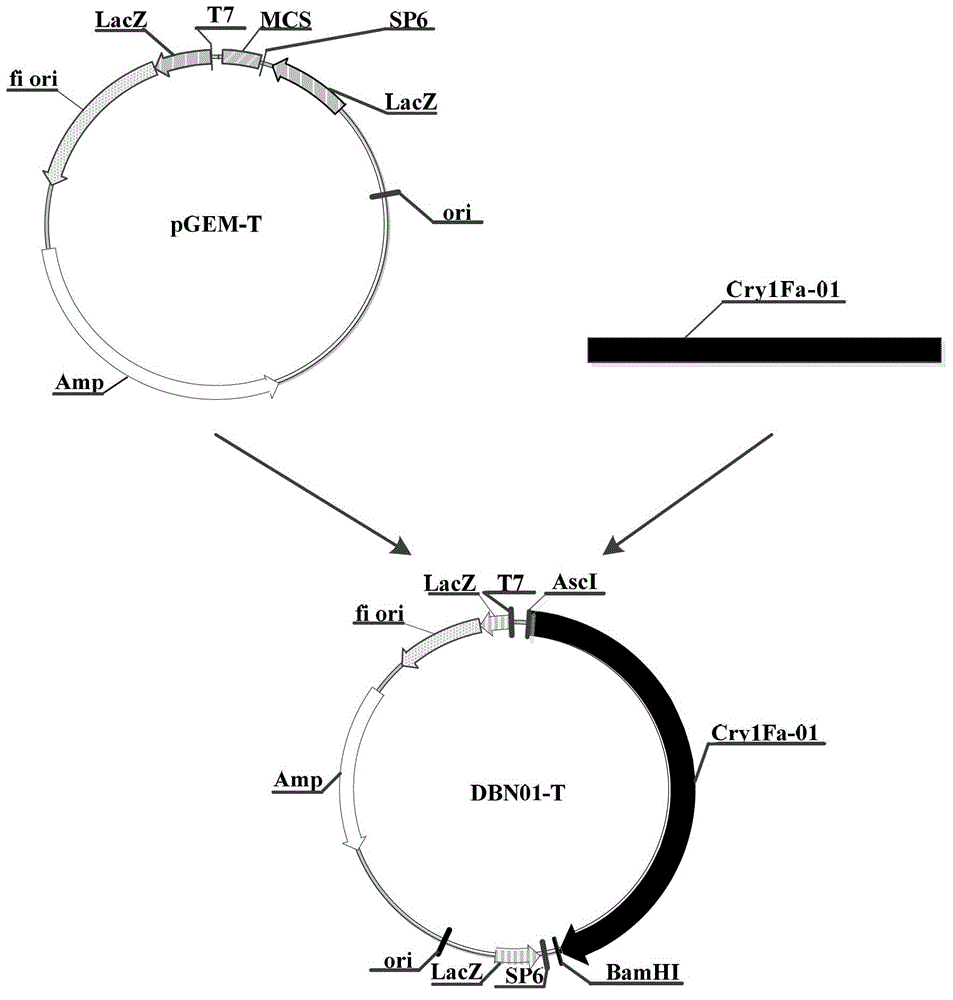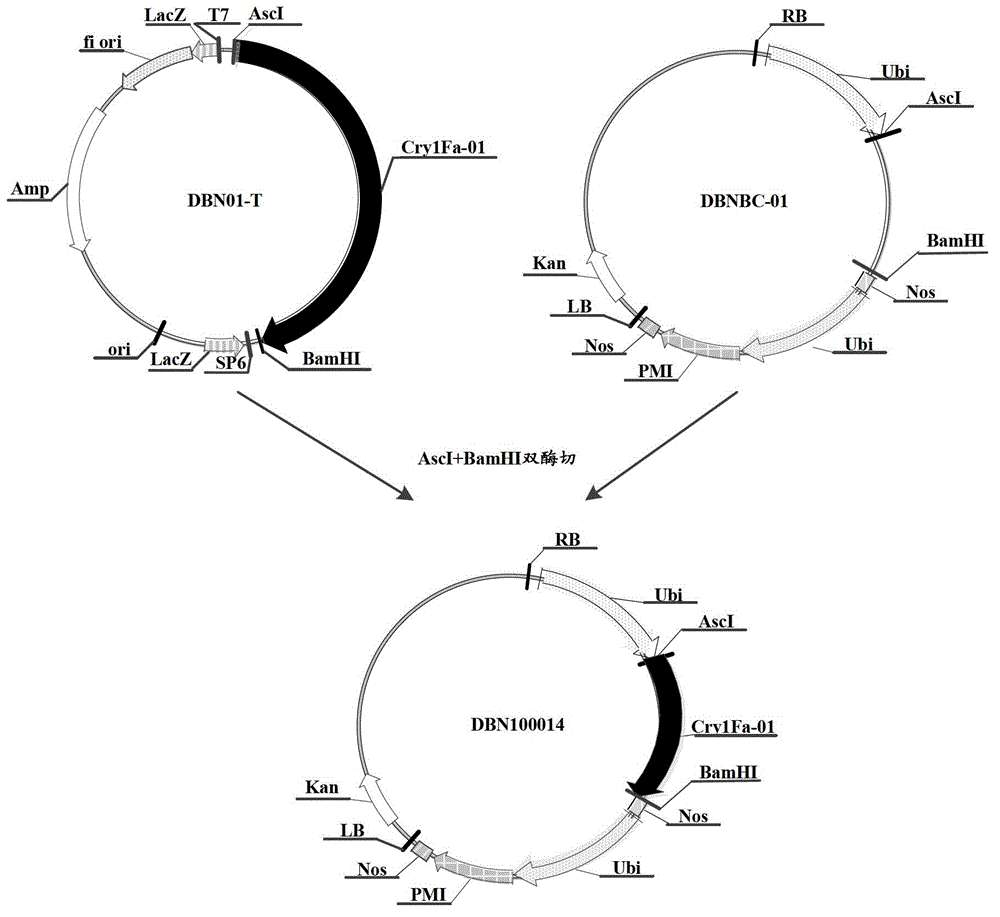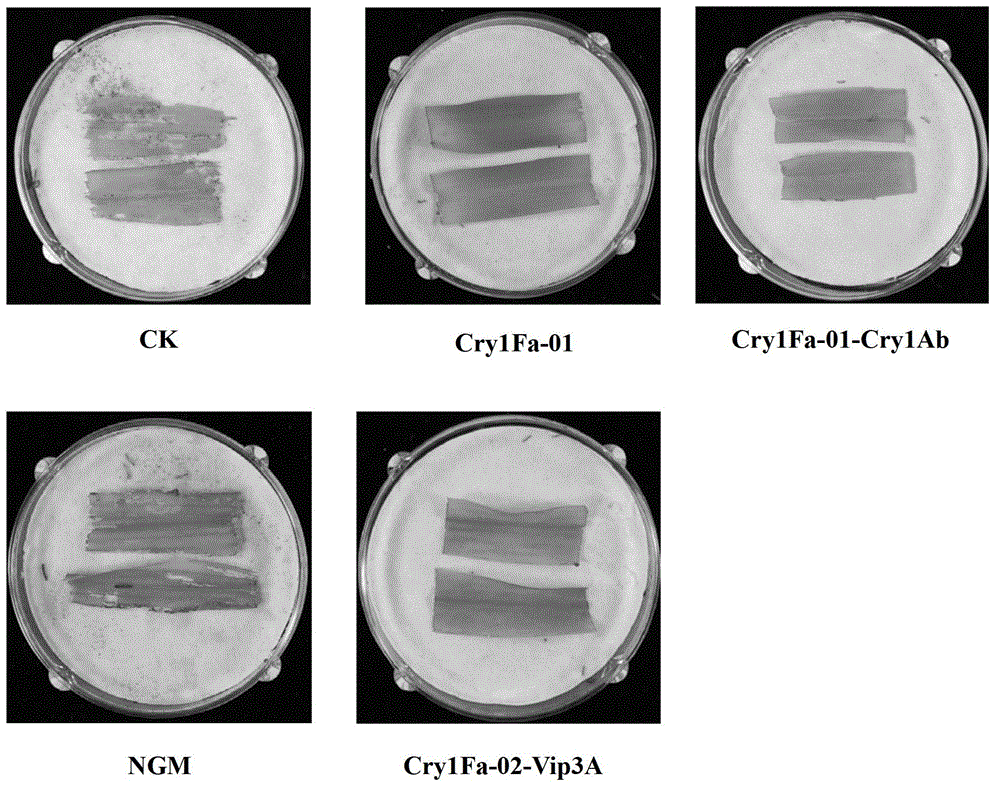Method for controlling pests
A technology for pests and Spodoptera frugiperda, applied in the field of pest control
- Summary
- Abstract
- Description
- Claims
- Application Information
AI Technical Summary
Problems solved by technology
Method used
Image
Examples
no. 1 example
[0084] The first embodiment, the acquisition and synthesis of Cry1Fa gene
[0085] 1. Obtain the Cry1Fa nucleotide sequence
[0086] The amino acid sequence (605 amino acids) of the Cry1Fa-01 insecticidal protein, as shown in SEQ ID NO: 1 in the sequence listing; Cry1Fa-01 encoding the amino acid sequence (605 amino acids) corresponding to the Cry1Fa-01 insecticidal protein Nucleotide sequence (1818 nucleotides), as shown in SEQ ID NO:3 in the sequence listing. The amino acid sequence (1148 amino acids) of the Cry1Fa-02 insecticidal protein, as shown in SEQ ID NO: 2 in the sequence listing; Cry1Fa-02 encoding the amino acid sequence (1148 amino acids) corresponding to the Cry1Fa-02 insecticidal protein Nucleotide sequence (3447 nucleotides), as shown in SEQ ID NO:4 in the sequence listing.
[0087] 2. Obtain the nucleotide sequences of Cry1A and Vip3A
[0088] The Cry1Ab nucleotide sequence (1848 nucleotides) encoding the amino acid sequence (615 amino acids) of the Cry1Ab ...
no. 2 example
[0091] The second embodiment, construction of recombinant expression vector and transformation of recombinant expression vector into Agrobacterium
[0092] 1. Construction of a recombinant cloning vector containing the Cry1F gene
[0093] The synthesized Cry1Fa-01 nucleotide sequence was connected to the cloning vector pGEM-T (Promega, Madison, USA, CAT: A3600), and the operation steps were carried out according to the instructions of the pGEM-T vector produced by Promega Company to obtain the recombinant cloning vector DBN01-T , its construction process is as follows figure 1 Shown (wherein, Amp represents the ampicillin resistance gene; f1 represents the replication origin of phage f1; LacZ is the LacZ start codon; SP6 is the SP6 RNA polymerase promoter; T7 is the T7 RNA polymerase promoter; Cry1Fa-01 is the Cry1Fa-01 nucleotide sequence (SEQ ID NO: 3); MCS is the multiple cloning site).
[0094] Then, the recombinant cloning vector DBN01-T was transformed into Escherichia...
no. 3 example
[0106] The third embodiment, the acquisition and verification of corn plants transferred to the Cry1F gene
[0107] 1. Obtaining corn plants transferred to the Cry1F gene
[0108] According to the commonly used Agrobacterium infection method, the immature embryos of the aseptically cultured maize variety Zong 31 (Z31) were co-cultured with the Agrobacterium described in 3 in the second example, so that the T-DNA in recombinant expression vectors DBN100014, DBN100012 and DBN100276 (including the promoter sequence of corn Ubiquitin gene, Cry1Fa-01 nucleotide sequence, Cry1Fa-02 nucleotide sequence, Cry1Ab nucleotide sequence, Vip3A nucleotide sequence , PMI gene and Nos terminator sequence) were transferred into the maize genome, and the maize plants transferred to the Cry1Fa-01 nucleotide sequence, the maize plants transferred to the Cry1Fa-01-Cry1Ab nucleotide sequence and the transferred Cry1Fa - the maize plant of 02-Vip3A nucleotide sequence; meanwhile, the wild type maize...
PUM
 Login to View More
Login to View More Abstract
Description
Claims
Application Information
 Login to View More
Login to View More - R&D
- Intellectual Property
- Life Sciences
- Materials
- Tech Scout
- Unparalleled Data Quality
- Higher Quality Content
- 60% Fewer Hallucinations
Browse by: Latest US Patents, China's latest patents, Technical Efficacy Thesaurus, Application Domain, Technology Topic, Popular Technical Reports.
© 2025 PatSnap. All rights reserved.Legal|Privacy policy|Modern Slavery Act Transparency Statement|Sitemap|About US| Contact US: help@patsnap.com



